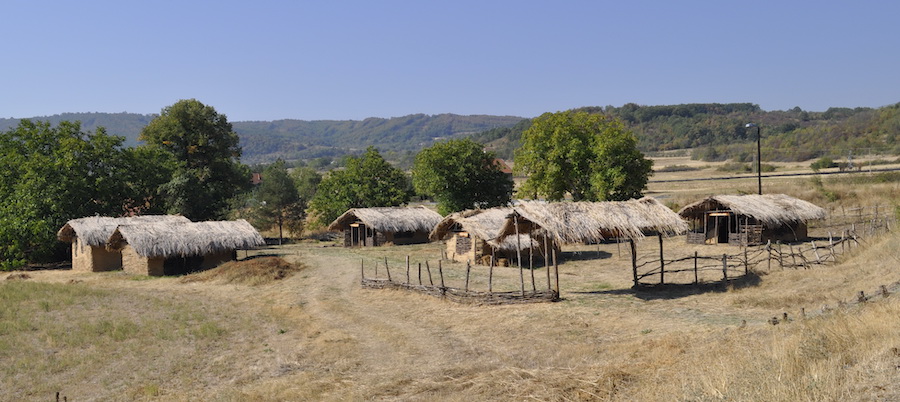attempto online
19.05.2020
Did pottery making influence the beginnings of metallurgy?
Researchers say it could have gone either way
When man learned to work metal thousands of years ago, a new age dawned - metallurgy fundamentally changed economy and society. But how had he acquired this ability in the first place? Researchers have long been discussing whether metallurgy learned from pottery making and their techniques or whether the two technologies developed independently. A new study led by Dr. Silvia Amicone (Competence Centre Archaeometry - Baden-Württemberg (CCA-BW), University of Tübingen) sheds new light on the debate. After analysing prehistoric finds, it concludes that metallurgy and pottery did indeed influence each other, but probably developed in parallel. The results were published in the Journal of Archaeological Science.
For decades researchers have been debating whether the earliest metallurgists gained their ability to control fire from potters or not. The missing piece of evidence in this debate, a solid archaeological example where one could study the technological developments of these two crucial technologies side-by-side, was finally located in eastern Serbia. It presents the earliest evidence for metal making, going back to 7,000 years ago in the prehistoric village of Belovode. The discovery prompted an international team of archaeologists and scientists from the UK, Serbia and Germany to start a 3-year long campaign of excavations in this and another contemporary prehistoric site in Serbia, Pločnik, in pursuit of the social and technological events that gave birth to metallurgy.
Both sites are remarkable for their rich material culture that includes dark-burnished and graphite painted pottery, often considered the precursors of metallurgy in this part of the world. Especially the use of graphite, a mineral naturally occurring in different areas of the Balkans, was closely related to the emergence of early metal production.
The new research led by Dr. Silvia Amicone (CCA-BW) gives, for the first time, insights into the contentious matter of pyrotechnological connections of pottery and metals: “Historically, it was assumed that high firing temperatures of 1000 °C or above and predominantly reducing atmosphere were necessary for the production of dark-burnished and natural graphite-painted pottery. The potters of the Late Neolithic Balkans who made these black-burnished ceramics already possessed a sophisticated understanding of pyrotechnology and the thermal behaviour of naturally occurring inorganic materials. This could well have led to the discovery of metallurgy, however this hypothesis was never tested from a scientific standpoint”, she argues.
The research funded by UK’s AHRC, was carried out using a multi-pronged scientific approach to the study of ceramics from Serbia, that holds the earliest metallurgy in the world. The scientific analyses were done in the laboratories of the Institute of Archaeology of the University College London together with Patrick Quinn and Thilo Rehren and at the CCA-BW in Tuebingen with Christoph Berthold.
The results allowed researchers to reconstruct the exact sequence prehistoric potters followed in order to make this eye-catching pottery. What they discovered was that high temperature was not the key – as previously thought – but rather the mastery of fire control to produce this decorated pottery. “These savvy potters knew exactly how to pace the firing process, when to open the kilns and add the graphite decoration or smudge the surface of the pots to produce this deep black colour”, adds Silvia Amicone.
“The exciting moment in this research was comparing the two technologies – pottery making and metal smelting from the same sites and reconstructed in the same laboratory conditions. What we discovered was the same two step principle of controlling the fire, requiring specialist knowledge to balance between the reducing and oxidising conditions inside the kilns or furnaces”, says Dr. Radivojević, lecturer in Archaeomaterials at UCL and specialist in early metallurgy in Eurasia who initiated and coordinated the project.
The team of researchers agreed that the technique that appears to have the strongest link with copper smelting is the graphite decoration, as it is the one that relies the most on a nuanced understanding of the balance of redox conditions.
However, new dating evidence has now shown that graphite-painted decorations occurs at the same time as copper smelting, not before it. ”It is likely that this technique and copper smelting were ‘close cousins’ rather than one being the precursor to the other, as both were benefiting from the pre-existing experience with dark-burnished pottery” says Professor Thilo Rehren, formerly at UCL and now at the Cyprus Institute.
“We are therefore inclined to think that both technologies are equally likely to have influenced each other, which is not the clear-cut answer the archaeological community might have wanted to hear. But it is the one that will prompt new ways of thinking and teaching the evolution of pyrotechnologies”, concludes Silvia Amicone.
Publication:
Silvia Amicone, Miljana Radivojevic, Patrick Sean Quinn, Christoph Berthold, Thilo Rehren: Pyrotechnological connections? Re-investigating the link between pottery firing technology and the origins of metallurgy in the Vinca Culture, Serbia. Journal of Archaeological Science 118 / 2020. https://doi.org/10.1016/j.jas.2020.105123
Author: Silvia Amicone
Contact:
Dr. Silvia Amicone
University of Tübingen
Competence Center Archaeometry- Baden-Württemberg
Phone +49 7071 29-76801
silvia.amiconespam prevention@uni-tuebingen.de
Dr Christoph Berthold
University of Tübingen
Competence Center Archaeometry- Baden-Württemberg
Phone +49 7071 29-72604
christoph.bertholdspam prevention@uni-tuebingen.de

